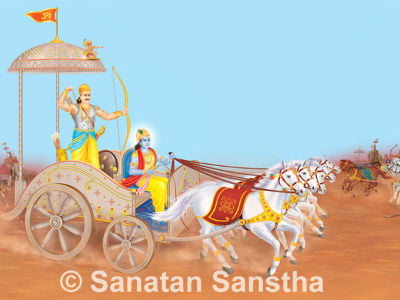
The Mahabharat and the Gita
1. The Mahabharat is the most important part of Krushna’s life. Written by Sage Vyas it is a prominent historical text. Bhiíhmacharya was the ‘Guru’ of the Kouravs in the Mahabharat. Before Bhishma’s birth His mother Ganga had abandoned His seven elder brothers (vasus) in the river Ganga. Krushna was the Guru of the Pandavs. Kansa had slain Krushna’s seven elder siblings.
2. At the time of the Bharatiya war Krushna was about 83 years old while Bhishma was more than 130 years old.
3. The Gita makes a mention only of the four persons given below.
| Person | Mode of speech (vani) | Characteristics |
|---|---|---|
| Dhrutarashtra | Vaikhari | Blind |
| Sanjay | Madhyama | One bestowed with divine vision |
| Arjun | Pashyanti | The soul |
| Krushna | Para | The Supreme God |
4. Krushna narrated the Gita only to Arjun for the following reasons.
- The confusion in Arjun’s mind was not due to emotions, it stemmed from intellect.
- Arjun was Gudakesha (v) that is the one who could comprehend the implied meaning (gudha means secret) in Keshav’s (Krushna’s) speech. At the beginning of the Gita Arjun tells Krushna, ‘Senayorubhayormadhye ratham sthapaya me chyut (सेनयोरुभयोर्मध्ये रथं स्थापय मेऽच्युत|)’ (Shrimadbhagvadgita 1:21). It means ‘O Achyut, place my chariot in the midst of both the armies’. Here, of the several Names of Krushna Achyut is used because Arjun is referring to the Krushna who does not deflect from His responsibilities, the one who is unflinching. ‘In the midst of both the armies’ implies between the good and the evil. Thus He asks Krushna to take him beyond all kinds of duality.
5. The Uddhavgita: When Krushna renounced His body His great friend Uddhav was greatly bereaved. What Krushna preached to him at that time is called the Uddhavgita.
6. Teachings of the Gita in brief : ‘In His philosophy He has shown the appropriate blend of attachment and detachment. He has accepted Karmayoga (Path of Action) according to the Vedas (The most sacred Hindu scriptures), Dnyanyoga (Path of Knowledge) according to the Sankhya (One of the six schools of Bharatiya philosophy) philosophy, suppression of tendencies of the subconscious mind according to Yogamarg (Path of Yoga) and sanyas (Renunciation) according to the Vedant (The Upanishads – a class of philosophical writings attached to the Brahmaṇ section of Vedas); but He has opposed the view that each of these is the ultimate as proclaimed by their exponents.
He has balanced the appropriate significant part of each one harmoniously and created a new doctrine based on actions devoid of expectations or results. The Bhagwadgita mainly preaches how man should carry out his duties. The scriptures decide our duties; but He has explained beautifully how to carry them out in the best possible way. In the Bhagwadgita, He has narrated to Arjun how to convert attachment to detachment and vice-versa, and how man should execute his duties.’
7. The Dnyaneshvari describes the Gita as
embellished with words. – 18:1684
8. Anugita: When Krushna realised that the effect of the Gita on Arjun’s mind was wearing out, He narrated it to him once again. This repetition is called the Anugita. Anu means later. So,the Anugita is the Gita which is narrated once again.
Reference: Sanatan’s Holy text, ‘Shrivishnu, Shriram and Shrikrushna‘

